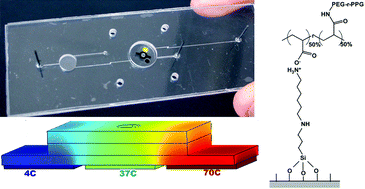In a chemostat, microbial cells reach a steady state condition at which cell biomass production, substrates and the product concentrations remain constant. These features make continuous culture a unique and powerful tool for biological and physiological research. We present a polymer-based microbioreactor system integrated with optical density (OD), pH, and dissolved oxygen (DO) real-time measurements for continuous cultivation of microbial cells. Escherichia coli (E. coli) cells are continuously cultured in a 150 µL, membrane-aerated, well-mixed microbioreactor fed by a pressure-driven flow of fresh medium through a microchannel. Chemotaxisial back growth of bacterial cells into the medium feed channel is prevented by local heating. Using poly(ethylene glycol) (PEG)-grafted poly(acrylic acid) (PAA) copolymer films, the inner surfaces of poly(methyl methacrylate) (PMMA) and poly(dimethylsiloxane) (PDMS) of the microbioreactor are modified to generate bio-inert surfaces resistant to non-specific protein adsorption and cell adhesion. The modified surfaces of microbioreactor effectively reduce wall growth of E. coli for a prolonged period of cultivation. Steady state conditions at different dilution rates are demonstrated and characterized by steady OD, pH, and DO levels.

You have access to this article
 Please wait while we load your content...
Something went wrong. Try again?
Please wait while we load your content...
Something went wrong. Try again?


 Please wait while we load your content...
Please wait while we load your content...